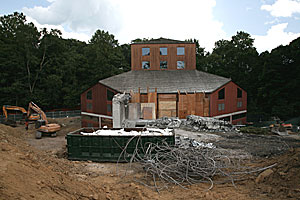A plan to enlarge the only surviving synagogue by Louis Kahn has sparked opposition among some preservationists, who call the alterations insensitive.
Completed in 1972, the 20,000-square-foot spruce-and-concrete home of Temple Beth El of Northern Westchester, in Chappaqua, New York, was intended to host services and classes for 400 families. But in recent years the congregation had swelled to more than 700 families, meaning it needed more space, says senior rabbi Joshua M. Davidson.


To alleviate crowding, the synagogue proposed nearly doubling its size with a 23,000-square-foot U-shaped wing by architect Alexander Gorlin, to contain classrooms, which are currently located in the existing building, and an event space. A groundbreaking occurred in May, and the $12 million project is expected to be finished by next summer.
With three low-slung, single-sloped-roof sections framing a courtyard, the wing is meant to evoke European villages like those in Estonia, where Kahn was born, Davidson says. In fact, many consider the existing synagogue’s eight-sided sanctuary to be inspired by those in Kahn’s native land.
The building is one of only two Kahn-designed synagogues ever built. The other, in Philadelphia, is today a Baptist church whose brick façade has been replaced with faux stone. Kahn died in 1974 at the age of 73.
“We came up with something that we think honors his legacy,” Davidson says, “and will allow us to grow and thrive as a congregation.”
Entryway Demolished
But the most controversial part of the plan is what’s already happened: the demolition of the synagogue’s boxy entryway to make way for a wider, taller version, which took place last week.
For opponents, who include architects and Kahn’s son, Nathaniel, a filmmaker, that effort to make access easier ruins a special aspect of the synagogue and a hallmark of Kahn’s works.
“He purposefully made it hard to enter his buildings, to draw distinctions between where you were and where you were going,” says Bill Whitaker, an architect who has curated the Kahn collection at the University of Pennsylvania for 17 years.
A similar example, he says, is the recently renovated 1955 Trenton Bath House in Ewing Township, New Jersey, a concrete-block structure with a tucked-away entrance.
But the synagogue is far from a perfect creation, says New York-based Gorlin, who taught courses about Kahn at Yale’s architecture school for a decade.
The main section, which features an airy sanctuary ringed by classrooms, lacks the types of connecting corridors found in similar houses of worship, like Kahn’s First Unitarian Church in Rochester, says Gorlin.
As a result, people have to cut across the sanctuary to get from one classroom to another, “so you could never have two things going on at the same time,” Gorlin says. Plus, he adds, eight of Kahn’s drawings that were discovered in the synagogue’s attic show Kahn intended an adjacent structure to be built on the site.
Still, despite his criticisms, the sanctuary and classrooms won’t be reconfigured; the wooden walls, however, will be refinished. Nothing else is planned for the interiors, according to Gorlin.
Pleas for Sensitivity
It’s not the first time that renovations of buildings by Kahn—considered one of the more prominent 20th-century architects, even if his oeuvre is limited—have generated criticism.
An early 1990s addition to the Salk Institute in La Jolla, California, was panned by many as being too imitative, and a proposed expansion of the Kimball Art Museum in Ft. Worth, Texas, from the same era, was so roundly condemned it was scrapped. (A more recent addition from Renzo Piano has many fans, however.)
While it may be too late to stop the synagogue expansion, opponents at least want care to be taken with the renovation of the walls, says Nathaniel Kahn, whose 2003 film, My Architect, is about his father.
Still, the loss of the entryway is painful, he says, likening it to lopping off the black-and-white introductory portion of the Wizard of Oz. “It would still be entertaining but robbed of its essential meaning,” Kahn says. “You can’t say that you are respecting the original design while taking away a part of it.”

Post a comment to this article
Report Abusive Comment